While the move from 3G to 4G was one small step for technology, the transition from 4G to 5G represents a quantum leap in how network ecosystems will function. The move to 5G will reshape our world by creating new innovations and an enormous wellspring of opportunities for the mobile industry and beyond.
Before we start, let’s explore why 5G isn’t just another evolution of network technology. 5G represents a fundamental shift in how networks can and will operate, with far-reaching effects for business, as noted by the MIT Technology Review:
“5G will become the underlying fabric of an entire ecosystem of fully connected intelligent sensors and devices, capable of overhauling economic and business policies, and further blurring geographical and cultural borders. It will be capable of delivering at every rung of the ecosystem’s ladder, and will provide seamless, continuous connectivity for business applications.”
Here in the United States, the 5G conversation became more interesting and more urgent for developers in the spring of 2018 when T-Mobile and Sprint agreed to merge, portending a near-term future where some 36 of America’s largest cities are served by ubiquitous 5G networks. The merger, if it goes through, will create a massive company with embedded brand recognition that will shake things up for developers and marketers—but when exactly, and how? To answer these questions, let’s start by understanding everything 5G brings to the table, then break the opportunity down to specific technical and economic ramifications.
What 5G brings to the mobile app party
The most noticeable difference for end-users of mobile devices connected to 5G networks will be a faster experience—possibly 10x faster than 4G. That means significantly reduced network latency (to as little as one millisecond, according to Qualcomm), much faster download times, and the capacity to connect and serve the billions of Internet of Things (IoT) devices that consumers and businesses will deploy in the coming years. The net result from a user standpoint will be a more consistent experience across all devices and channels, and a corresponding spike in expectations for fast and efficient brand engagements.
“In 2035, 5G will enable $12.3 trillion of global economic output.” – IHS
From a business standpoint, 5G will unleash a huge amount of revenue opportunity across all industries—up to $12.3 trillion globally, according to IHS Economics. That’s equivalent to almost all U.S. consumer spending in 2016. 5G is also expected to create millions of jobs globally, with app developers identified as one of the core career groupings that stand to benefit, alongside infrastructure and content providers.
Perhaps most significantly, 5G will serve as a springboard for accelerated innovation in app genres where developers and marketers are deeply invested: IoT, artificial intelligence, AR/VR, and business applications.
Industries that will benefit from 5G

Let’s start with an industry that is close to home for many of our clients and partners: mobile gaming. Simply stated, the mobile gaming experience is about to get a whole lot better. Greater speed and reduced latency means developers can add new levels of detail to their games. Developers will also be able to deliver smooth, deeply immersive AR and VR experiences anywhere there’s 5G coverage. This will be of particular significance for those developing multiplayer gaming apps and Pokémon Go-like experiences that bridge the physical-digital divide. Companion apps for live events like sports and concerts will flow real-time stats, layer augmented experiences, and connect athletes and entertainers to fans like never before.
But it’s not just fun and games. 5G will change the way both governments and businesses deliver critical services. Again referencing MIT Technology Review: “In health care, emergency response personnel can deliver more immediate diagnoses and care in cooperation with specialized remote medical care workers by assessing patients through high-fidelity video chats enhanced with AR overlays that display data collected through biometric sensors.” The same 5G experience that makes it possible to deliver this next level of care will be harnessed by enterprises to power a new generation of business apps that leverage the opportunities of data integration and machine learning.
“Unlike its predecessors though, 5G is a technological paradigm shift, akin to the shift from typewriter to computer.” – MIT Technology Review
For example, the energy industry, which has long struggled with issues of scale and transparency, will suddenly be able to use real-time data about weather, crowds, and critical incidents to manage power intelligently and react more quickly to outages or other failures in the grid, gas pipelines, or water treatment plants.
Other data-dependent applications in shipping, warehousing, and other areas of the logistics industry will change the way goods move between nations, flowing over 5G networks, and managed by mobile applications purpose-built for a broad range of use cases.
Beyond the 5G hype are hard questions
On the surface, the T-Mobile and Sprint merger looks like it could be a catalyst for driving innovation and growth for mobile app developers and marketers, but that’s far from certain. First of all, the deal must be approved by regulators. The primary question here is whether the merger would be anti-competitive in a U.S. market already dominated by just four major players—Sprint, T-Mobile, AT&T, and Verizon control about 95% of the market—which also raises the question of whether the combined 5G network proposed by the merger would result in lower prices and better service for users.
“The drive to compete on costs when you’re nearly as big as the legacy carriers makes no sense,” writes Jamal Carnette on The Motley Fool. “What does make sense is maximizing economic rent through price-leadership and other semi-collusive pricing actions.”
There’s also the question of whether the proposed merger may actually slow down the rollout of 5G in the United States rather than accelerate it. Consider that prior to the merger announcement, both Sprint and T-Mobile had announced their intention to roll out 5G in multiple markets over 2018 and early 2019. Some of those markets—New York and Los Angeles for example—overlap.
“With fewer carriers to compete, it’s likely there will be less competition to improve service.” – Jamal Carnette
Network operators do not put hundreds of millions of dollars into network infrastructure without the intent to monetize it. To assume that a dual network presence for the merged entity would mean greater horsepower for developers and better deals for consumers is very optimistic.
History (as recent as 4G LTE, or going back a little further, the move from copper to fiber) indicates that unprofitable network investments tend to slow down the introduction of new technology as networks attempt to minimize the impact of those unproductive investments. As the potential of 5G screams for developer attention and consumers’ expectations for faster, better experiences grow, the reality is that regulators and network operators in the U.S. may elect to throw out the anchor and slow the 5G ship’s acceleration to market, delaying commercial opportunity for app developers in all genres.
Whether a 5G utopia comes next year or sometime in the 2020s, now is the time for developers to start imagining the possibilities it might enable. Government regulators, corporate maneuvers, and the physical constraints of actual construction all may delay its deployment, but 5G is coming. What developers do with it is what will make it real.









